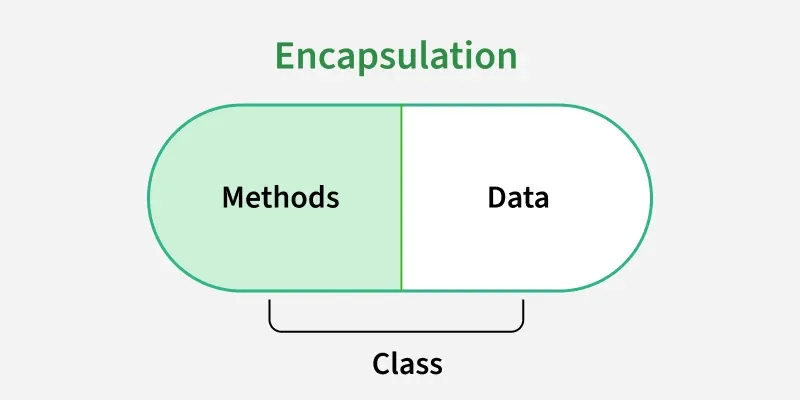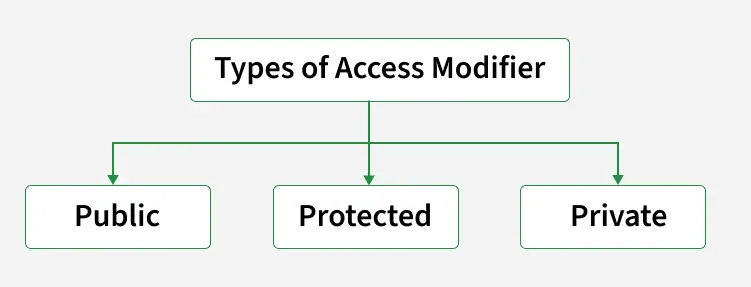Encapsulation means hiding internal details of a class and only exposing what’s necessary. It helps to protect important data from being changed directly and keeps the code secure and organized.
This example shows encapsulation by keeping __salary variable private inside Employee class. It cannot be accessed directly from outside the class.
Python class Employee: def __init__(self, name, salary): self.name = name # public attribute self.__salary = salary # private attribute emp = Employee("Fedrick", 50000) print(emp.name) print(emp.__salary) Output
Fedrick
ERROR!
Traceback (most recent call last):
File "<main.py>", line 8, in <module>
AttributeError: 'Employee' object has no attribute '__salary'
Explanation:
- self.name = name: Public attribute, can be accessed directly.
- self.__salary = salary: Private attribute, cannot be accessed directly.
- print(emp.name): Prints "Fedrick" because name is public.
- print(emp.__salary): Raises an error because __salary is private and hidden.

Why do we need Encapsulation?
- Protects data from unauthorized access and accidental modification.
- Controls data updates using getter/setter methods with validation.
- Enhances modularity by hiding internal implementation details.
- Simplifies maintenance through centralized data handling logic.
- Reflects real-world scenarios like restricting direct access to a bank account balance.
Access Specifiers
Access specifiers define how class members (variables and methods) can be accessed from outside the class. They help in implementing encapsulation by controlling the visibility of data. There are three types of access specifiers:
 Types of Access Modifiers
Types of Access ModifiersLet's discuss it one by one.
1. Public Members
Public members are variables or methods that can be accessed from anywhere inside the class, outside the class or from other modules. By default, all members in Python are public.
They are defined without any underscore prefix (e.g., self.name).
Example: This example shows how a public attribute (name) and a public method (display_name) can be accessed from outside the class using an object.
Python class Employee: def __init__(self, name): self.name = name # public attribute def display_name(self): # public method print(self.name) emp = Employee("John") emp.display_name() # Accessible print(emp.name) # Accessible Explanation:
- self.name: Declared without underscores, so it is public.
- display_name(): Public method that prints the value of the public attribute.
- emp.name: Directly accessed from outside the class, showing public members are fully accessible.
Note: __init__ method is a constructor and runs as soon as an object of a class is instantiated.
2. Protected members
Protected members are variables or methods that are intended to be accessed only within the class and its subclasses. They are not strictly private but should be treated as internal.
In Python, protected members are defined with a single underscore prefix (e.g., self._name).
Example: This example shows how a protected attribute (_age) can be accessed within a subclass, demonstrating that protected members are meant for use within the class and its subclasses.
Python class Employee: def __init__(self, name, age): self.name = name # public self._age = age # protected class SubEmployee(Employee): def show_age(self): print("Age:", self._age) # Accessible in subclass emp = SubEmployee("Ross", 30) print(emp.name) # Public accessible emp.show_age() # Protected accessed through subclass Explanation:
- self._age: Defined with a single underscore, marking it as protected.
- SubEmployee: Inherits from Employee and can access _age directly.
- Protected members should not be accessed outside the class hierarchy, but Python does not enforce this rule strictly.
3. Private members
Private members are variables or methods that cannot be accessed directly from outside the class. They are used to restrict access and protect internal data.
In Python, private members are defined with a double underscore prefix (e.g., self.__salary). Python applies name mangling by internally renaming them (e.g., __salary becomes _ClassName__salary) to prevent direct access.
Example: This example shows how a private attribute (__salary) is accessed within the class using a public method, demonstrating that private members cannot be accessed directly from outside the class.
Python class Employee: def __init__(self, name, salary): self.name = name # public self.__salary = salary # private def show_salary(self): print("Salary:", self.__salary) emp = Employee("Robert", 60000) print(emp.name) # Public accessible emp.show_salary() # Accessing private correctly # print(emp.__salary) # Error: Not accessible directly OutputRobert Salary: 60000
Explanation:
- self.__salary: Defined with double underscores, so it is private.
- show_salary(): A public method that provides safe access to the private attribute.
- Attempting emp.__salary causes an AttributeError, proving private members cannot be accessed directly.
Declaring Protected and Private Methods
In Python, you can control method access levels using naming conventions:
- Use a single underscore (_) before a method name to indicate it is protected meant to be used within class or its subclasses.
- Use a double underscore (__) to define a private method accessible only within class due to name mangling.
Note: Unlike other programming languages, Python does not enforce access modifiers like public, private or protected at the language level. However, it follows naming conventions and uses a technique called name mangling to support encapsulation.
Example: This example demonstrates how a protected method (_show_balance) and a private method (__update_balance) are used to control access. The private method updates balance internally, while protected method displays it. Both are accessed via a public method (deposit), showing how Python uses naming conventions for encapsulation.
Python class BankAccount: def __init__(self): self.balance = 1000 def _show_balance(self): print(f"Balance: ₹{self.balance}") # Protected method def __update_balance(self, amount): self.balance += amount # Private method def deposit(self, amount): if amount > 0: self.__update_balance(amount) # Accessing private method internally self._show_balance() # Accessing protected method else: print("Invalid deposit amount!") account = BankAccount() account._show_balance() # Works, but should be treated as internal # account.__update_balance(500) # Error: private method account.deposit(500) # Uses both methods internally OutputBalance: ₹1000 Balance: ₹1500
Explanation:
- _show_balance(): (Protected method) Accessible from outside, but intended for internal or subclass use.
- __update_balance(): (Private method) Only accessible inside class due to name mangling.
- deposit(): Public method that safely uses both private and protected methods.
Getter and Setter Methods
In Python, getter and setter methods are used to access and modify private attributes safely. Instead of accessing private data directly, these methods provide controlled access, allowing you to:
- Read data using a getter method.
- Update data using a setter method with optional validation or restrictions.
Example: This example shows how to use a getter and a setter method to safely access and update a private attribute (__salary).
Python class Employee: def __init__(self): self.__salary = 50000 # Private attribute def get_salary(self): # Getter method return self.__salary def set_salary(self, amount): # Setter method if amount > 0: self.__salary = amount else: print("Invalid salary amount!") emp = Employee() print(emp.get_salary()) # Access salary using getter emp.set_salary(60000) # Update salary using setter print(emp.get_salary()) Explanation:
- __salary is a private attribute, so it can't be accessed directly from outside the class.
- get_salary() is a getter method that safely returns the current salary.
- set_salary(amount) is a setter method that updates the salary only if the amount is positive.
- The object emp uses these methods to access and modify the salary while keeping the data protected.
Explore
Python Fundamentals
Python Data Structures
Advanced Python
Data Science with Python
Web Development with Python
Python Practice
My Profile